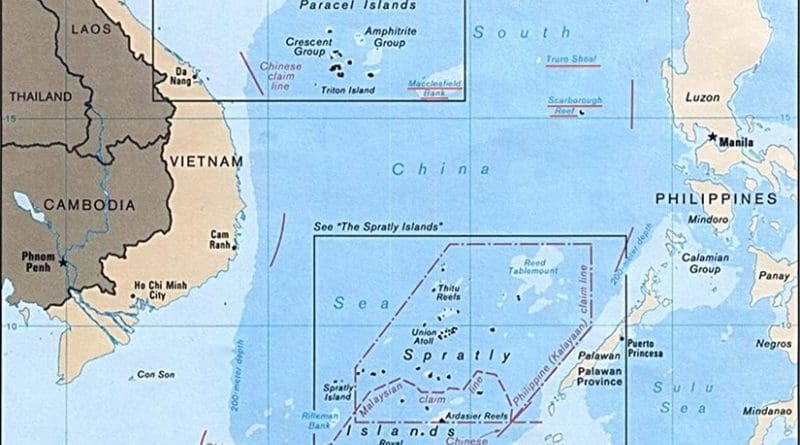South China Sea: China’s Double Speak And Verdict At The Hague – Analysis
By IPCS
By Vijay Shankar*
When Premier Xi rubbished the 12 July 2016 verdict of the International Permanent Court of Arbitration at The Hague on China’s claims over most of the South China Sea, what exactly was meant? For no international justice system had thus far ever called China to order for its expansionist strategy.
What The Hague had in fact done was not only to uphold the case filed by the Philippines in 2013, after China seized a reef in the Scarborough Shoal; but also condemned China’s conduct in the South China Sea (SCS) over construction of artificial islands and setting up military infrastructure. In an unequivocal rebuke,it found China’s expansive claim to sovereignty over the waters had no legal basis, historical or otherwise. The verdict gives motivation to the governments of Brunei, Indonesia, Malaysia, Vietnam and Taiwan to pursue their maritime disputes with Beijing in the Permanent Court of Arbitration (PCA). Small wonder then is Premier Xi’s fulmination.
The central issue before the PCA was the legality of China’s claim to waters within a so-called “nine-dash line” that appears on official Chinese charts. It encircles 90 per cent of the SCS, an area of 1.9 million square kilometres approximately equal to the combined areas of Afghanistan, Pakistan and Myanmar put together. Philippines’ contention was that China’s claims were in violation of the United Nations Convention on the Law of the Sea (UNCLOS), which both China and the Philippines have ratified. In its decision, the tribunal said any historic rights to the sea that China claimed “were extinguished” by the treaty. And its failure to be a party to the deliberations in no way bars the proceedings. The UNCLOS lays out rules for drawing zones of control over the world’s oceans and seas based on coastal orientation, while the concept of Historic Waters means waters that are treated as internal waters where there is no right of innocent passage.
As far as the “nine-dash line” (originally eleven-dash) is concerned; following the surrender of Japan in 1945, China produced a proprietorship chart titled “Position of the South China Sea Islands” that showed an eleven-dash line around the islands. This map was published by the Republic of China government in February 1948. It did not hold onto this position after it fled to Taiwan. The Chinese Communist Party, however,persisted with this cartographic notion, modifying the 11 to 9 dashes when in 1957, China ceded Bailongwei Island in the Gulf of Tonkin to North Vietnam.
The PCA concluded that China had never exercised exclusive authority over the waters and that several disputed rocks and reefs in the SCS were too small for China to claim control of economic activities in the waters around them. As a result, it found China outside the law in as much as activities in Philippine waters are concerned. The tribunal cited China’s construction of artificial islands on the Mischief Reef and the Spratly archipelago as illegal in addition to the military facilities thereon which were all in Philippine waters.
The episode has besmirched the image of Xi Jinping, his politburo and indeed the credibility of the Communist Party of China (CPC). To lose their legal case for sovereignty over waters that they have heavily invested in must come as a rude shock to their global aspirations. A complaisant response may set into motion the unravelling of the CPC’s internal hold on the state as defence of maritime claims is central to the CPC’s narrative. Any challenge to this account is seen in Beijing as a challenge to the Party’s rule. But the die has been cast; it remains to be seen how more regions and neighbours respond to China’s unlawful claims wherever it is perceived to exist. An indication of the regional response was Vietnam’s immediate endorsement of the tribunal’s decision.
Thus far China has responded sardonically with a typical Cold War propagandist style avowal. “We do not claim an inch of land that does not belong to us, but we won’t give up any patch that is ours. The activities of the Chinese people in the South China Sea date back to over 2,000 years ago” said the front-page in the People’s Daily, which ridiculed the tribunal as a “lackey of some outside forces” that would be remembered as a “laughingstock in human history.” Such dippy doublespeak has no place in contemporary geopolitics. For China to do nothing about the matter will be difficult in the extreme. It does not take a political pundit to note that some form of immediate coercive military manoeuvre in the SCS is in the offing. Also, it would hardly be realistic to expect China to scurry away to dismantle the military infrastructure it has so far set up; more likely it is their revisionist policies that would be reviewed.
Towards the end of the Cultural Revolution, in 1976, China brought out a movie titled “Great Wall in the South China Sea;” it was not about the inward looking narrative of Chinese civilisation but of “expansive conquests that would knit together all of South East Asia.” The Hague’s verdict has grievously injured the latter strategy. And if the free world is to rein in China’s bid to rewrite the rule books, including the right to unimpeded passage in the SCS, then it would do well to convince her of the illegitimacy of her position. In the meantime, Indian diplomacy should promote the littorals of the SCS to seek arbitration for their maritime disputes with China at The Hague.
* Vijay Shankar
Former Commander-in-Chief, Strategic Forces Command of India

